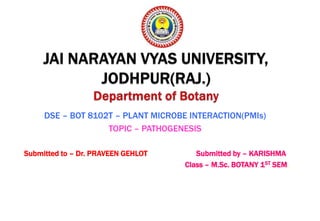
PATHOGENESIS SEMINAR PPT 2023 - By Karishma
- 1. DSE – BOT 8102T – PLANT MICROBE INTERACTION(PMIs) TOPIC – PATHOGENESIS Submitted to – Dr. PRAVEEN GEHLOT Submitted by – KARISHMA Class – M.Sc. BOTANY 1ST SEM.
- 2. CONTENT :- 1.Pathogenesis Introduction & Defenition 2.Parasitism & Pathogenecity 3.Disease Cycle & Development 4.Events in Disease Cycle - a) Inoculation b) Penetration c) Perception and Recognition between Host and the pathogen d) Infection e) Invasion f) Growth and Reproduction of the pathogen, g) Dissemination of the pathogen, and h) Survival of the pathogen. In some diseases there may be several infection cycles within one diseases cycle.
- 3. PATHOGENESIS INTRODUCTION & DEFENITION :- Pathogenesis :- is the chain of events that led to development of disease in the host (or) sequence of progress in disease development from the initial contact between the pathogen and host to the completion of the syndrome. 1. It can include factors which contribute not only to the onset of the disease or disorders, but also to it’s progression and maintenance. 2. This process which involves Inoculation, Penetration, Establishment of infection, Colonization (Invasion), growth and reproduction of the pathogen, Dissemination of the pathogen, and Survival of the pathogen is called pathogenesis.
- 4. Parasitism - ■The removal of food by a parasite from its host. In some cases, both the plant & the microbe benefit from the association called symbiosis. Pathogenicity - ■The ability of the parasite to interfere with one or more of the essential functions of the host, causing disease. ■ Parasitism plays an important role, but not the most important role in pathogenicity.
- 5. Disease Cycle Pathogenesis/ Disease Cycle – a series of events that occur in succession during a pathogenic relationship of a pathogen and host that leads to disease. The study of disease cycle generate information about - - Source of perpetuation of pathogen - Mode of spread - Help in formulation of control measures A pathogen's life cycle may follow events similar to the disease cycle.
- 6. Disease Development -Disease triangle -Disease tetrahedron
- 8. Inoculation - • It is the process by which the pathogen come in contact with its host. - Inoculum: any part of pathogen that can cause disease (may consist of single unit of the pathogen or whole of the pathogen).
- 9. Penetration The process by which the pathogen enter its host Varies in different pathogens. The penetration process is divided into - • Pre-penetration process • Penetration • Post penetration process Penetration Process Types • Direct penetration • Indirect penetration — Fungi may penetrate in either way — Bacteria mostly enter through wounds and some time by natural openings — Viruses, viroids, phytoplasma etc. by mechanical means (wounds) and by vector.
- 12. PERCEPTION - Perception means how pathogen and host recognize each other. It may take place directly or indirectly.
- 13. Recognition Between Host & The Pathogen It is assumed that when a pathogen comes in contact with the host cell, an early events takes place that trigger a fairly rapid response in each organism which either allows or impedes further growth of the pathogen and development of the disease. The nature of early events is not known with certainty in any host-pathogen combination; — however, it may be one of the many biochemical substances structures and pathways. — These may include specific host signal compound or structures or either of them may induce specific action or formation of specific products by the other organism.
- 14. Infection - Establishment of organic relationship of the pathogen with susceptible cells of the host plant is called infection. Infection process is affected by various factors - — Resistance & susceptibility of the host — Aggressiveness & virulence of the pathogen — Environmental factors — Host nutrition & pH — Incubation period ( depends upon host- pathogen combination, stage of host and environment etc.
- 15. Infection is of different types – 1. Localized infection 2. Systemic infection 3. Latent infection
- 16. Invasion and reproduction are the two concurrent stages that occur during infection as pathogen invade different cells, grow & multiply. INVASION Pathogens enters to variable extents inside the host. Different pathogens invade their host as:- — Ectoparasite e.g. powdery mildew — Endoparasites e.g. wilts, viruses etc. Sub-cuticular pathogens (Apple scab- Venturia inequalis) Sub-epidermal pathogens (wheat rust ) Vascular pathogens (Pseudomonas solanacearum) — Ecto-endo parasites e.g. potato canker (Corticium solani).
- 18. Growth & Reproduction Different pathogens grow intercellulary & intracellularly inside their host. Growth & reproduction rate depends upon invasion behaviour of the pathogen. Method of reproduction - — Asexual — Sexual — Replication in case of majority of sub-microscopic pathogens. Growth and reproduction of the pathogen is affected by - ─ Pathogen aggressiveness ─ Susceptibility of the host tissue ─ And environmental factors.
- 19. Dissemination of The Pathogen- Transfer of inoculum - a.) Passive - wind, water, insects, man, animals, machinery b.) Active - move on own power bacteria (some) Pythium(Zoospores) Fungi- spores expelled forcibly
- 20. Pathogen Survival - 1. In infected crop debris 2. In seed 3. In soil 4. On growing plants 5. Infected material on host plants 6. In propagating material 7. Alternate host 8. Collateral host 9. As dormant-structures e.g. sclerotia.
- 21. Refrences – 1. Fungal Pathogenesis in Plants and Crops (2nd edition) by P. Vidhyasekaran 2. Plant Diseases (9th edition) by R.S. Singh 3. Class notes by Dr. Praveen Gehlot 4. http//wikipedia.com/pathogenesis 5. http//googlescholer.com/pathogenesis etc.